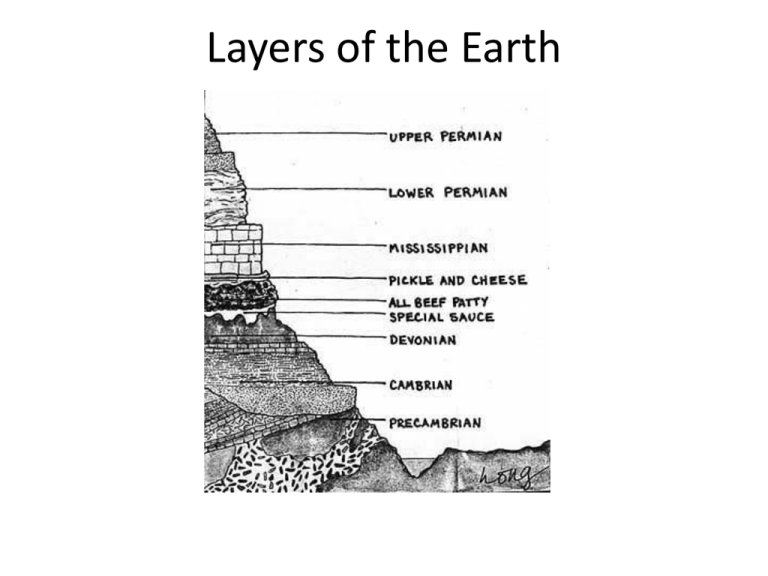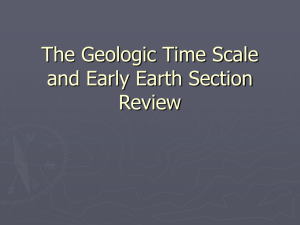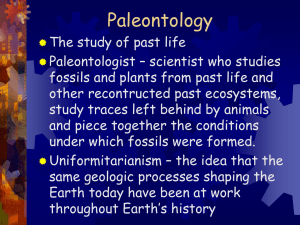Ch 18 Notes
advertisement

Layers of the Earth 18.1 The Geologic Time Scale The Geologic column – represents a timeline of Earth’s history, with the oldest fossils at the bottom. Geologic Column See Text p. 375 (Great uncomformity) The Construction of the Geologic Column No single area on earth contains a record of all geologic time, so scientists combine their observations from around the world to create a standard arrangement of rock layers. What do we call the line between layers B and C? The Geologic Column is based on hundreds of years of scientific research from all over the world. • Divided by major changes in climate, or the extinction of a large group of organisms. Period – characterized by specific fossils Named for the location in which the rocks containing the identifying fossils were first found. Epoch – subdivision of Cenozoic ONLY! Cenozoic has an abundance of extremely detailed fossil record. Only in the Cenozoic are Periods divided into Epochs. We live in the Cenozoic Era, the Quaternary Period, and Holocene Epoch ! Divisions of Geologic Time Extinction of species is predicted by evolution. 18.2 Geologic History Theory of Evolution Organisms change over time, and new kinds of organisms are derived from ancestral types. 1. 2. 3. 4. Proposed by Charles Darwin in 1859 Individual in a population vary in each generation Some of these variations are genetic, or inherited More individuals are produced than live to grow up and reproduce Individuals with some genes are more likely to survive and reproduce than others. The fossil record is more evidence for evolution. Many organisms do not survive. If fact, 99% of all organisms that have ever lived are now extinct. How species evolve 18.2 Geologic History Era – largest unit of geologic time 1. Precambrian time • oldest layers of the geologic column • lasted much longer than other eras • very few fossils have been found o early Precambrian, bacteria & algae o late Precambrian, primitive worms, sponges, and coral Evidence that life began in the ocean 2. Paleozoic Era – Meaning “ancient life” From 325 – 180 million years ago Wide variety of fossils, both marine and land plants and animals Periods: Permian – Pangaea comes together; 95% mass extinctions Carboniferous – Amphibians flourish, sea stars common; forests & swamps; giant insects Devonian – Age of fishes; 1st amphibians; ferns & cone-bearing plants develop Silurian – 1st Echinoderms; eurypterids (sea scorpions); 1st land plants and animals appear Ordovician – Trilobites decline; 1st vertebrates appear (fishes) Cambrian – Trilobites & brachiopods common Brachiopods Trilobite Earliest fish: ostracoderms Eurypterids Horsetails 3. Mesozoic era – Meaning “middle life” From 180 – 65 million years ago More-complex fossils like reptiles and birds Periods: Cretaceous – 1st flowering plants; mass extinction of all non-avian dinosaurs (~ 75% of species mass extinction) Jurassic – Dinosaurs dominant; flying reptiles & first birds Triassic – Ammonites common; cycads & conifers; first mammals appear 4. Cenozoic – Meaning “recent life” From 65 million ago Fossils of mammals common Periods: Quaternary – Holocene: End of last ice age; complex human societies Pleistocene: Woolly mammoths, rhinos, and early humans Tertiary – Pliocene: large carnivores (bears, dogs, cats) Miocene: Grazing herds abundant; raccoons, wolves Oligocene: deer, pigs, horses, a, cats, and dogs Eocene: horses, flying squirrels, bats, whales Paleocene: Age of mammals begins; lemuroids Timeline compressed to 1 Year Jan 1 – Earth is formed Feb 25 – First cells July 17 – First cells with nuclei Nov 18 – First animals evolve Dec 1 – First tetrapods (4 legs) Dec 14 – First mammals Dec 26 – Mass extinction of the dinosaurs Dec 31 – Humans first appear at 11:35 pm Dec 31 – Humans build Stonehenge about 11:59:30 http://www.slate.com/blogs/bad_astronomy/2012/12/31/history_of_earth_video_of_earth_s_timeline_compressed_into_one_minute.html Earth time Music video Geologic Time Music Video- BlethwynFilms (by “The Script”) http://www.youtube.com/watch?v=7PQURsc2SYs Words to song above http://www.youtube.com/watch?v=FXpeovWDi9k National Geographic: The Story of Earth HD (1:30:01) http://www.youtube.com/watch?v=Xsn3wpVAcjk Timeline Pictures Early fishes bacteria crinoids brachiopods cyanobacteria early life Early echinoderms eurypterids trilobites echinoderms Paleozoic









